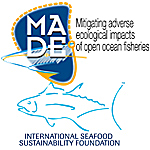Within the two recent decades many coastal and island countries have developed longline fishery targeting swordfish in their EEZs and international waters. Nowadays this fishing gear is a primary worldwide method for landings of largest size of pelagic fishes. While swordfish is the target species, this fishery yields numerous species of epipelagic predatory community such as scombrids, billfish, sharks and rays, other teleost fish, reptiles, and birds. Incidental catch (bycatch) is a crucial management issue for LSF in an Ecosystem Approach to Fisheries context since many of the non-target species are discarded dead. Many of these non-target species are susceptible to fishing pressure and cannot sustain current level of non-targeting exploitation. In this study we explore the fishing time as a mitigation measure to reduce bycatch in LSF. Fishing surveys with a longline equipped with time depth recorders and hook timers were carried out in the South West Indian Ocean. Capture time for swordfish and non-target species were analysed, in order to investigate potential time difference in the hooking contacts among different species. Moreover, an optimal time window optimizing the Catch per Unit Effort (CPUE) for the target species with respect to the ratio between bycatch groups and the target species was identified. Finally, the opportunity of changing the fishing strategy (setting and hauling periods, soaking time) to mitigate the impact of LSF on bycatch focused on both sharks and commercial bycatch species was discussed.
- Presentation

 PDF version
PDF version
